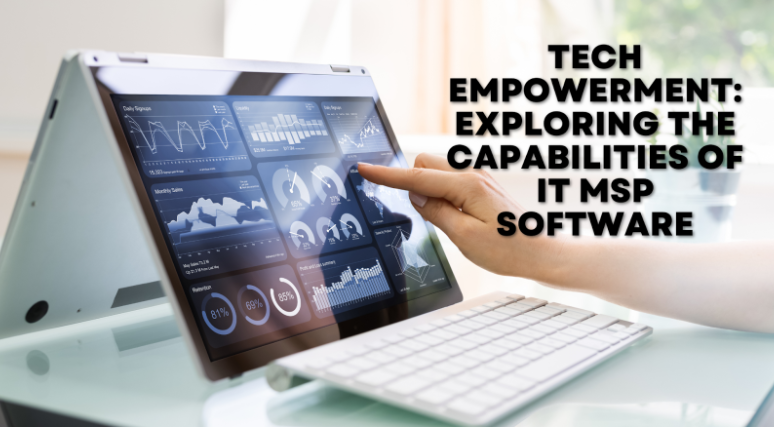Tech Empowerment: Exploring the Capabilities of IT MSP Software
In today’s digital era, managing a company’s IT infrastructure is more complex than ever. With employees relying heavily on cloud applications, mobile devices, and remote access, ensuring operational efficiency, security, and business continuity is a formidable challenge.
This is where Managed Service Provider (MSP) software comes into the picture, serving as a powerful technology to empower businesses through robust IT infrastructure management and process automation.
Introduction
Over the past decade, MSP software has emerged as a pivotal tool to help manage, monitor, and optimize an organization’s IT assets and services. From network monitoring to endpoint security and everything in between, MSP solutions enable businesses to centralize oversight of their critical IT operations.
This robust solution serves as a linchpin for organizations, streamlining their IT management processes and enhancing overall efficiency. IT MSP software acts as a comprehensive tool, offering a centralized platform for monitoring, managing, and optimizing various IT functions. With the seamless integration of IT MSP software, businesses can proactively address issues, ensure network security, and optimize performance.
The versatility of IT MSP software extends to remote monitoring, proactive problem resolution, and resource optimization, providing businesses with the agility to adapt to the ever-evolving technological landscape. By harnessing the capabilities of IT MSP software, organizations can embark on a journey of tech empowerment, ensuring a resilient and efficient IT infrastructure that aligns seamlessly with their business objectives.
Key Features of MSP Software
MSP software offers an array of features and functionalities aimed at streamlining IT management and infrastructure monitoring.
Automation
One of the primary advantages of MSP software is the automation of manual and repetitive IT tasks. It enables the creation of scripts and workflows to carry out functions like server monitoring, patch management, backup automation, and more. By leveraging automation, IT teams can focus on high-value strategic initiatives rather than mundane upkeep tasks.
Remote Monitoring and Management
One of the key capabilities of MSP software is enabling remote oversight and control of the IT environment. Additionally, remote monitoring and management functionality allows MSPs to track assets, troubleshoot issues, deploy patches, and automate tasks across client networks irrespective of geographic boundaries. This is invaluable for managing multi-site IT infrastructure.
Real-Time Alerting and Ticketing
This MSP software platform integrates real-time alerting and ticketing to facilitate instant issue resolution. With customizable alerts and process workflows, businesses can identify and respond to network failures, security threats, and other IT incidents in real-time, minimizing downtime.
Robust Reporting and Analytics
Data-driven insights are integral for efficient IT management. MSP software solutions enable the creation of custom reports and dashboards to get real-time visibility into asset inventory, system health metrics, network traffic patterns, and other trends. This allows IT teams to optimize infrastructure proactively.
Enhanced Security
Modern MSP software integrates advanced security capabilities like anti-virus, firewall management, data encryption, and identity management. Its security tools provide 360-degree protection and access control across client networks and endpoints. This fortifies the IT environment against emerging cyber threats.
Specialized Solutions
MSP platforms offer specialized add-ons to serve niche business needs. Some tools offer Apple device management, 3D mapping, disaster recovery, and legacy systems illustrating the versatility of MSP software in addressing varied IT infrastructure demands.
Benefits of MSP Software for Businesses
The diverse features and capabilities of MSP software translate into tangible benefits for businesses when leveraged optimally:
Enhanced productivity– By automating repetitive tasks, MSP software enables IT teams to focus on high-value initiatives, boosting productivity.
Cost efficiency – MSP software reduces the need for additional IT staff and infrastructure spending through process automation. This leads to significant cost savings.
Operational agility – With real-time monitoring and management, IT infrastructure can be scaled and optimized dynamically based on evolving needs, enhancing operational agility.
Reduced downtime – With automated alerts and rapid response facilitated by MSP software, IT downtime is significantly minimized, ensuring business continuity.
Bolstered security – Advanced security capabilities of MSP software fortifies networks and endpoints against modern cyber threats, strengthening data and IP protection.
Improved compliance – MSP software enables standardized and centralized management procedures to meet operational, regulatory, and data compliance requirements.
Enhanced visibility and control – With detailed analytics and dashboards, businesses gain granular visibility across their IT infrastructure to optimize performance proactively.
By leveraging these benefits, MSP software enables organizations to achieve the strategic advantage of resilient and efficiently managed IT infrastructure.
Quantifying the Impact of MSP Software
The true measure of any technology ultimately lies in its quantifiable impact. The following statistics validate the transformative role of MSP software:
The worldwide IT security market is projected to reach $188.1 billion by 2025, underscoring the business-critical need for robust cybersecurity facilitated by MSP software.
Public cloud services revenue is forecasted to reach $592 billion in 2022, highlighting MSP software’s pivotal role in enabling seamless multi-cloud infrastructure management.
A survey finds that 60% of respondents achieved over 20% cost savings after switching to an MSP platform, quantifying the software’s impact on cost optimization.
These statistics affirm that MSP software has evolved beyond utility; it is now a transformative force scaling new heights of tech empowerment for modern businesses.
Conclusion
As IT infrastructure and security needs become increasingly complex, MSP software has emerged as the linchpin helping businesses optimize IT management while unlocking new realms of operational efficiency, visibility, and continuity. The future will witness even tighter integration between MSP software and innovations like AI, ML, and cloud automation to maximize infrastructure resilience and empower business growth. As the global managed services market continues to grow, it’s clear that MSP software will be the driving force behind tech empowerment’s new horizons.
FAQs
1. What are the key advantages of using MSP software?
The main benefits include cost savings, improved productivity, enhanced security, increased visibility and control, reduced downtime, and automation of repetitive tasks. MSP software centralizes and optimizes IT management.
2. What core capabilities should businesses look for in MSP software?
Key capabilities include remote monitoring and management, real-time alerting, security tools, automation, reporting and analytics, and specialized solutions catering to niche business needs. A robust MSP software platform will integrate these functionalities.
3. How does MSP software enhance business security?
MSP software fortifies cybersecurity by facilitating endpoint protection, access control, data encryption, firewall management, vulnerability assessments, and compliance management across client networks. This provides 360-degree security.
4. Does MSP software require significant upfront investment?
No, leading MSP software follows a subscription model, enabling businesses to start small and scale infrastructure management capabilities based on evolving needs. This optimizes cost and flexibility.
5. Can MSP software integrate with a business’s existing IT infrastructure?
Yes, most MSP software platforms provide APIs and connectors to integrate seamlessly with current IT infrastructure components, whether on-premise or cloud-based. This enables centralized management.




